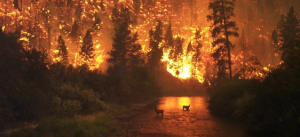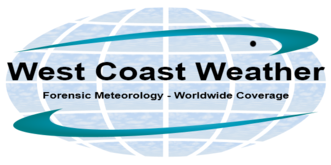West Coast Wildfires and the Monsoon
By Michael FaginLightning, WildfiresWith 0 commentsDoes the southwestern monsoon cause West Coast Wildfires? Monsoons are best known for bringing monsoonal rains but the term specifically refers to a change in a wind pattern, which may enable the presence of inclement weather.
A wet monsoon may be a blessing if fighting flames. When winds sourced from the oceans moisten the hot, dry, continental, southwestern air, the atmosphere attempts to resolve the difference by redistributing the air, which can lead to vertical transport and perhaps copious condensation, generating potentially heavy rains.
Around the areas that do receive rain, it’s typically windy and lightning prone. Sometimes entire storms from the southwestern monsoon are dry. In fact, the pattern is notorious for brewing mostly dry storms that generate frequent and sometimes cloud-to-ground lightning. Incidentally, the problems pertaining to the southwestern monsoon causing West Coast wildfires aren’t as simple as the arrival or absence of monsoonal storms.
On average, does the southwestern monsoon cause West Coast wildfires more often than it extinguishes them? Some seasons are wetter than others but the composite of local variables tends to play the most important role in where ignitions may occur. For example, microclimates such as sloping terrain are extra susceptible to winds and excess heat, leading to dryness.
1-8’’ of rain annually from monsoon season is typical in a southwestern city – very little relative to storm patterns on, for instance, the East Coast. Totals tend to rise where the desert is less dominant, especially around the windward sides of mountains. Some springtime snowpack over the west central US is known to enhance the monsoon in some areas to the east. Partially due to scarcity in the regional atmosphere, the monsoon is also known to take turns feeding from the moisture source that, if in the presence of more easterly winds, also feeds the Great Plains.
When the dew point – contingent on the available moisture – stays constant but the temperature rises, the relative humidity drops and so does the chance for rain. Dryness in the air around the desert is linked to higher temperatures but cooler than normal temperatures in the Gulf of California can make the desert southwest even drier. When the monsoon is dry, dust storms may be able to form, which far from help plantlife maintain moisture. A so-called “biblical” event rolled through Phoenix recently .
Despite the aridity, the monsoon’s semi-regularity has allowed plantlife to grow dependent upon its arrival. There’s only about a century’s worth of reliable historical weather data to reference but the fact that thousands of species of plants have found ways to adapt indicates the monsoon is tens to hundreds of millions of years old. Its nature has gradually adjusted in accordance with the ever-changing atmosphere and tectonic plate movements.
There is a lot of microvariability to West Coast weather due to myriad known factors, such as sun duration, elevation, soil type, proximity to bodies of water, freezing, thawing, flora density, flora types, etc., and likely other unknown or at least partially misunderstood environmental factors. The path that a southwestern monsoonal storm takes tends to be forced by the specific orography around the location, which may enhance winds and lead to stretches that see more rain. Where desert vegetation can grow reveals a lot about the land nearby or sometimes miles away, and also what can be expected as of late from the skies above.
Does the Southwestern Monsoon Cause West Coast Wildfires Single-handedly
Many of the analyses of the frequency and intensity of West Coast wildfires have assessed it in terms of climate change. While it can affect where plants can grow, that direction of research tends to ignore their natural defenses to atmospheric changes. Since the first potentially ignitable vegetation emerged, wildfires have been an adversary of living plants. What is opening the door for the increasingly familiar giant blazes along the West Coast?
Most are accidentally or arsonistically started by humans. Of the lightning-sparked fires, the monsoon causes a dominant share.
Even if land is struck by cloud-to-ground lightning, starting a noteworthy inferno is not as simple as getting a fire started: all the right ingredients must be present. Typically, something needs to first lower a forest’s defenses.
A prominent factor weakening trees is bugs, damaging them until they either dry out and die or die then dry out – nature disrupting nature’s preventative mechanisms. Wood borers seek out and attack fire-damaged trees. Vulnerable trees in hot temperatures are breeding grounds for bark beetles, such as the Douglas fir beetle, the fir engraver and turpentine beetles. The other most notable desert southwestern forest pests are moths, aphids and scales.
All the dead plant life – from insects, dehydration and disease – is expanding the size and count of wildfires. Will nature find a way to adapt; and, if so, will humanity still be around to notice?

Written by Meteorologist Geoff Linsley
